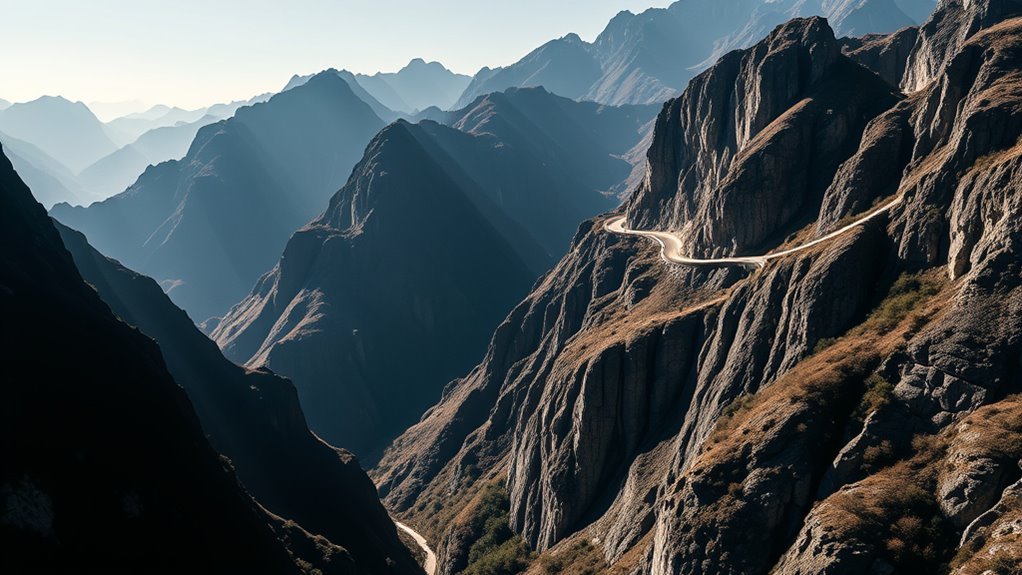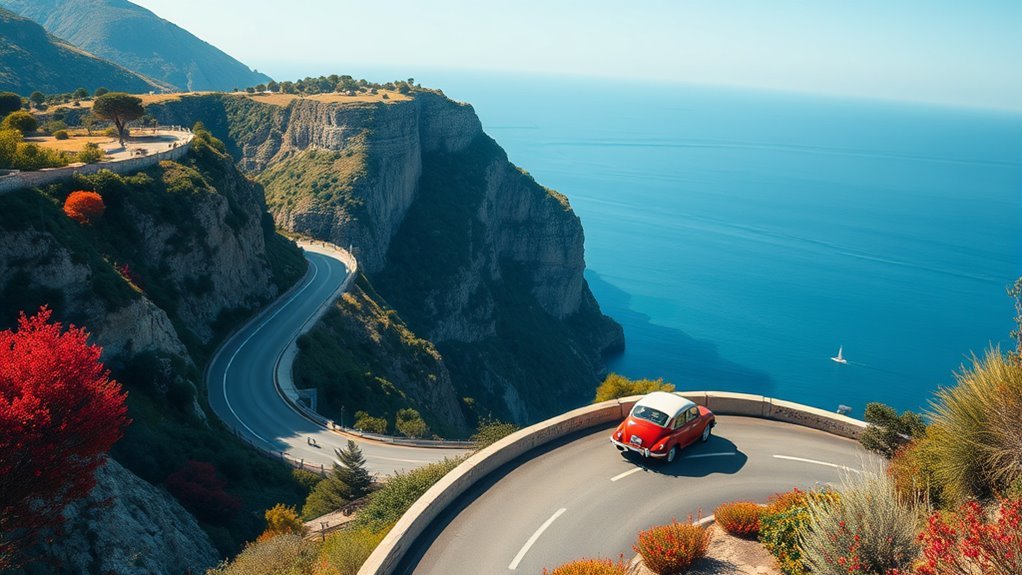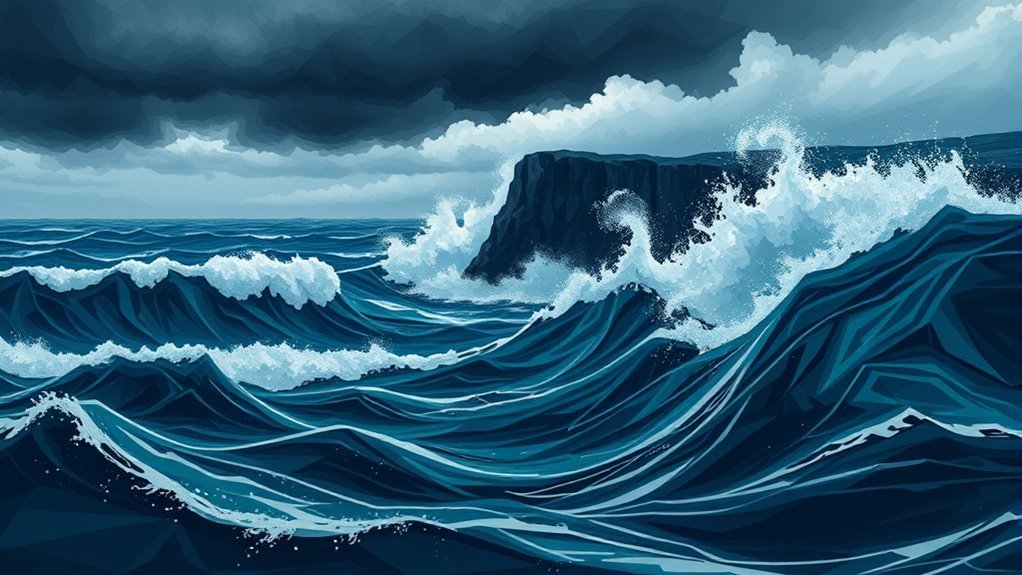The most dangerous roads and waterways for squall-induced accidents include North Yungas Road in Bolivia, known for its steep cliffs and lack of guardrails. Guoliang Tunnel Road in China presents narrow passages and rockfalls. The Pacific Coast Highway in the USA features sudden weather changes, while Romania's Transfagarasan Highway poses risks from sharp turns. The Amalfi Coast Road in Italy has treacherous cliffs. On the water, the Bay of Biscay and the Great Lakes are notorious for unpredictable storms. More about these hazards awaits.
Main Points
- North Yungas Road in Bolivia is infamous for its steep cliffs and poor visibility during squalls, increasing accident risks.
- Guoliang Tunnel Road in China features narrow passages and potential rockfalls, making it perilous during sudden weather changes.
- The Pacific Coast Highway in the USA has sudden weather shifts that create hazardous driving conditions along its steep cliffs.
- The Amalfi Coast Road in Italy presents sharp turns and diminished visibility during squalls, exacerbating the risk of accidents.
- The Bay of Biscay is known for high waves and turbulent waters during squalls, posing significant challenges for mariners.
The North Yungas Road, Bolivia
Known as one of the most hazardous routes in the world, the North Yungas Road in Bolivia poses considerable risks for travelers, especially during squall conditions.
This narrow, winding road, often referred to as "Death Road," is notorious for its steep cliffs and lack of guardrails. Visibility can drastically diminish during heavy rain, making navigation dangerous.
The road, which connects La Paz to the Yungas region, is frequently shrouded in mist, further complicating travel.
The terrain is rugged, with loose gravel and mudslides common after squalls. Cyclists and motorists alike face the constant threat of accidents, as a single miscalculation can result in fatal consequences.
Furthermore, the area's unpredictable weather patterns can create sudden and hazardous conditions. Travelers are urged to exercise extreme caution and consider alternative routes when forecasts predict adverse weather, as the risks associated with the North Yungas Road are particularly pronounced during squall events.
Guoliang Tunnel Road, China

Guoliang Tunnel Road in China is renowned for its unique construction, carved through a mountain, presenting considerable challenges for drivers.
Weather conditions, particularly squalls, can exacerbate safety risks on this narrow passage.
Historical accident statistics further highlight the dangers associated with traversing this extraordinary yet hazardous route.
Tunnel Road Characteristics
Carved into the side of a mountain, the Guoliang Tunnel Road in China exemplifies the challenges and dangers associated with tunnel road characteristics. This narrow passageway, measuring only 4 to 5 meters in width, provides limited space for vehicles to maneuver, heightening the risk of collisions.
The road's construction required blasting through solid rock, resulting in uneven surfaces and potential rockfalls, which pose considerable hazards. Additionally, the tunnel features sharp bends and steep drops, creating difficulties for drivers, especially those unfamiliar with the terrain.
Inadequate lighting further complicates visibility, particularly during adverse conditions. Altogether, the unique design and natural topography of the Guoliang Tunnel Road contribute to its reputation as a treacherous route for motorists.
Weather Impacts on Safety
Although the Guoliang Tunnel Road offers stunning views, weather conditions can severely compromise safety for drivers traversing this precarious route.
Frequent squalls can lead to reduced visibility, making navigation through the narrow tunnel exceptionally hazardous. Rain can create slippery surfaces, increasing the risk of skidding or losing control.
Additionally, sudden gusts of wind can impact vehicle stability, particularly for larger vehicles. Fog can further obscure sightlines, causing delays in reaction times.
The combination of these weather factors makes the road particularly treacherous during squall events. Drivers must remain vigilant and adjust to rapidly changing conditions to minimize the likelihood of accidents, as the unique geography of the area can enhance the dangers posed by adverse weather.
Historical Accident Statistics
Accident statistics for the Guoliang Tunnel Road reveal a concerning pattern that highlights the dangers posed by both the road's design and the frequent adverse weather conditions.
This narrow, cliffside road has been the site of numerous accidents, particularly during squall events that exacerbate visibility and road traction. Data indicates that over the past decade, the road has experienced a notable uptick in collisions, often resulting in severe injuries or fatalities.
Factors contributing to these incidents include sharp turns, limited guardrails, and sudden drops. In addition, heavy rains and strong winds can lead to landslides, further complicating travel.
These statistics underscore the urgent need for improved safety measures to mitigate risks associated with this hazardous route.
The Pacific Coast Highway, USA

The Pacific Coast Highway is renowned for its stunning views and dramatic coastline, but it also presents considerable hazards due to frequent weather changes.
Drivers must maneuver sharp turns and steep cliffs, making the road both picturesque and risky.
The combination of natural beauty and unpredictable conditions often leads to squall-induced accidents, highlighting the dangers intrinsic in this celebrated route.
Frequent Weather Changes
While traversing the Pacific Coast Highway, drivers often encounter sudden weather shifts that can create hazardous conditions.
This coastal route is notorious for its unpredictable climate, with fog, rain, and strong winds frequently emerging without warning. Such rapid changes can reduce visibility and affect road traction, leading to an increased risk of accidents.
The combination of steep cliffs and narrow lanes further compounds these dangers, making it essential for drivers to remain vigilant and prepared for any weather-related surprises.
Additionally, the interplay of ocean currents and local topography can enhance squalls, necessitating constant attention to forecasts.
In the end, understanding these frequent weather changes is vital for ensuring safety along this scenic yet dangerous highway.
Scenic Yet Treacherous
Known for its breathtaking views and dramatic coastal scenery, the Pacific Coast Highway also presents substantial challenges for drivers. The winding roads, perched precariously along cliffs, can become dangerous during squalls, with sudden gusts of wind and reduced visibility. Rain can lead to slippery surfaces, increasing the risk of accidents.
Additionally, the highway attracts a mix of tourists and local drivers, resulting in unpredictable traffic patterns. Scenic overlooks can tempt drivers to stop abruptly, further heightening the danger.
Despite its beauty, the Pacific Coast Highway requires constant attention and caution, as nature's sudden changes can transform a picturesque drive into a hazardous journey. Drivers must balance the allure of the scenery with the road's inherent dangers.
The Transfagarasan Highway, Romania

Transfagarasan Highway in Romania presents a breathtaking yet treacherous route, often highlighted for its stunning mountain scenery. Stretching over 90 kilometers, this highway traverses the Carpathian Mountains, connecting the regions of Transylvania and Wallachia.
Its sharp turns, steep inclines, and frequent weather changes pose notable risks, particularly during squalls. Rain and sudden fog can reduce visibility, making navigation dangerous for drivers. The road's elevation, reaching over 2,000 meters, exacerbates these dangers, as icy patches can form unexpectedly, leading to accidents.
Furthermore, the highway attracts numerous tourists, increasing traffic congestion and the likelihood of collisions. Despite these hazards, the Transfagarasan is renowned among thrill-seekers and adventurers, who are drawn to its dramatic vistas and exhilarating driving experience.
Caution is essential for those who venture onto this iconic yet risky roadway, especially during unpredictable weather conditions.
The Amalfi Coast Road, Italy

As travelers traverse the Amalfi Coast Road in Italy, they are often captivated by its stunning coastal views and picturesque villages.
Nevertheless, this scenic route poses considerable dangers, especially during unexpected squalls. The road winds precariously along steep cliffs, with sharp turns and narrow lanes that can become treacherous when heavy rain and wind strike suddenly. Visibility may diminish rapidly, and the potential for landslides increases, further complicating navigation.
Additionally, the influx of tourists often leads to congested traffic, exacerbating the risk of accidents during adverse weather conditions. Drivers unfamiliar with the route may struggle to modify to its challenges, heightening the likelihood of squall-induced mishaps.
Consequently, caution is essential for those attempting to enjoy the breathtaking beauty of the Amalfi Coast Road, as the juxtaposition of its allure and danger creates a unique yet hazardous driving experience.
The Bay of Biscay, Spain and France
While the Bay of Biscay offers breathtaking views and rich marine life, it is also notorious for its hazardous conditions, particularly during squalls. This body of water, located between Spain and France, experiences sudden and severe weather changes that challenge even the most skilled mariners.
The convergence of Atlantic currents and coastal winds creates a volatile environment, frequently resulting in high waves and turbulent waters. Fishermen and recreational boaters are often caught off guard by these rapid shifts, leading to accidents and capsizing incidents.
The bay's rugged coastline, defined by steep cliffs and rocky outcrops, compounds the risks faced by those traversing its waters. Additionally, the frequent fog and poor visibility during squalls can obscure critical navigational markers, increasing the likelihood of collisions.
As a result, the Bay of Biscay stands as a stark reminder of nature's power, demanding respect and caution from all who venture into its depths.
The Great Lakes, USA and Canada
The Great Lakes, a collection of five interconnected freshwater lakes straddling the border between the USA and Canada, are renowned for their extensive beauty and recreational opportunities.
Nevertheless, these immense waters can quickly become dangerous due to sudden squalls. The unpredictable weather patterns characteristic of the region can lead to rapid drops in temperature and visibility, creating hazardous conditions for vessels.
Strong winds can generate tumultuous waves, challenging even experienced sailors. Reports indicate that squall-induced accidents often occur in these waters, particularly during late spring and early fall when temperature fluctuations are most pronounced.
In addition, the sheer size of the lakes can cause delays in rescue operations, further exacerbating the dangers associated with squall conditions.
As a result, mariners in the Great Lakes must remain vigilant and prepared for sudden weather changes to maneuver safely through these beautiful yet risky waters.
Common Questions
What Precautions Should Drivers Take in Squall-Prone Areas?
When driving in squall-prone areas, individuals should reduce speed, maintain a safe distance from other vehicles, utilize headlights, and remain vigilant for sudden weather changes to guarantee safety and prevent accidents.
How Can Squalls Affect Navigation on Waterways?
Squalls can considerably disrupt navigation on waterways by creating sudden, strong winds and reduced visibility. These conditions pose risks for vessel stability, steering control, and safe passage, necessitating vigilant monitoring and prompt response from navigators.
Are Squalls Predictable in These Dangerous Regions?
Squalls, defined by sudden wind shifts and intense precipitation, can be challenging to predict in dangerous regions. Meteorological advancements improve forecasting, yet their rapid onset often leaves little time for navigators to respond effectively.
What Safety Gear Is Essential for Traveling These Roads?
Essential safety gear for traveling dangerous roads includes a high-visibility vest, emergency flares, a first aid kit, a flashlight, sturdy footwear, and a reliable vehicle with proper tires and brakes to guarantee preparedness for adverse conditions.
How Do Local Authorities Respond to Squall-Related Accidents?
Local authorities typically respond to squall-related accidents by dispatching emergency services, evaluating road conditions, implementing traffic control measures, and providing assistance to affected individuals. They also issue weather advisories to inform the public about potential hazards.

